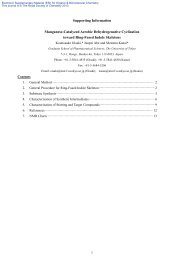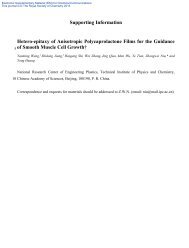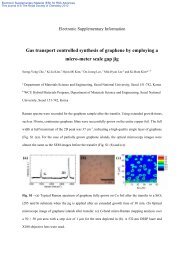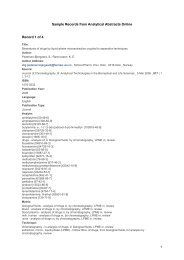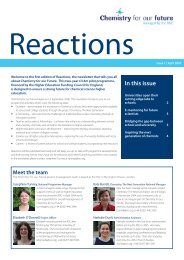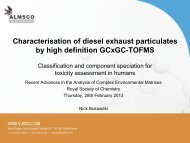Representation of Ethnic Groups in Chemistry and Physics
Representation of Ethnic Groups in Chemistry and Physics
Representation of Ethnic Groups in Chemistry and Physics
Create successful ePaper yourself
Turn your PDF publications into a flip-book with our unique Google optimized e-Paper software.
3: Methodology<br />
9. HESA data are also available<br />
for 1996/1997 <strong>and</strong><br />
2001/2002, <strong>and</strong> these are used<br />
for comparison, where<br />
appropriate.<br />
10. This analysis was undertaken<br />
as an <strong>in</strong>vestigative data exercise<br />
comb<strong>in</strong><strong>in</strong>g Asian <strong>and</strong> black<br />
groups as broad ethnic<br />
categories. Even at this very<br />
coarse level <strong>of</strong> aggregation,<br />
sample numbers were<br />
prohibitively small. An analysis <strong>of</strong><br />
broad employment patterns for<br />
the populations as a whole is<br />
available from the authors on<br />
request.<br />
Table 3: Sample numbers <strong>in</strong> the YCS, based on<br />
merged cohorts 1996–2002<br />
<strong>Ethnic</strong>ity<br />
white<br />
black Caribbean<br />
black African<br />
Indian<br />
Pakistani<br />
Bangladeshi<br />
Ch<strong>in</strong>ese<br />
mixed race<br />
other<br />
Total<br />
Comb<strong>in</strong>ed YCS sample<br />
28 704<br />
140<br />
115<br />
874<br />
546<br />
229<br />
189<br />
249<br />
527<br />
31 573<br />
Note: In cohort 7, a detailed ethnic breakdown for the black population is<br />
not available. Similarly, numbers for mixed race <strong>and</strong> other m<strong>in</strong>orities are<br />
comb<strong>in</strong>ed for this cohort. In these <strong>in</strong>stances, totals are given for cohorts 8,<br />
9 <strong>and</strong> 10 only.<br />
Source: Youth Cohort Study<br />
universities <strong>and</strong> from other higher-education <strong>in</strong>stitutions,<br />
<strong>in</strong>clud<strong>in</strong>g details relat<strong>in</strong>g to current students, staff <strong>and</strong> <strong>in</strong>formation<br />
about recent leavers. Two relevant data sets are<br />
utilised <strong>in</strong> this study:<br />
● The student data set This is an annual census <strong>of</strong><br />
students undertak<strong>in</strong>g studies at UK universities at the<br />
time <strong>of</strong> survey, <strong>in</strong>clud<strong>in</strong>g students on both<br />
undergraduate <strong>and</strong> postgraduate courses.<br />
● First dest<strong>in</strong>ation data set This is an annual census <strong>of</strong><br />
the activities <strong>of</strong> graduates approximately six months<br />
after complet<strong>in</strong>g their courses, <strong>in</strong>clud<strong>in</strong>g details<br />
regard<strong>in</strong>g further study <strong>and</strong> economic activity. This<br />
data set provides <strong>in</strong>formation about the degree<br />
classification obta<strong>in</strong>ed by students on the completion<br />
<strong>of</strong> their undergraduate studies.<br />
HESA student data set for the academic year<br />
2002/2003 are used to analyse student numbers at both<br />
undergraduate <strong>and</strong> postgraduate level. 9 Primarily this is<br />
done <strong>in</strong> relation to chemistry <strong>and</strong> physics, but the data also<br />
provide <strong>in</strong>formation about student choice with regard to<br />
alternative areas <strong>of</strong> study (e.g. other science subjects or<br />
alternative vocational routes, such as medic<strong>in</strong>e-related<br />
subjects, bus<strong>in</strong>ess <strong>and</strong> law). The first dest<strong>in</strong>ation data set<br />
is analysed to exam<strong>in</strong>e achievement by degree classification<br />
<strong>and</strong> patterns <strong>of</strong> further study by ethnic group, based<br />
on data for the academic year 2001/2002.<br />
F<strong>in</strong>ally, note that to achieve consistency with GCSE <strong>and</strong><br />
A-level data, the analysis <strong>of</strong> HESA data is restricted to students<br />
domiciled <strong>in</strong> Engl<strong>and</strong> <strong>and</strong> Wales.<br />
3.1.4: Labour Force Survey<br />
The LFS is a sample survey <strong>of</strong> households liv<strong>in</strong>g at private<br />
addresses <strong>in</strong> the UK. The surveys are conducted on a quarterly<br />
basis <strong>and</strong> provide data about approximately 65 000<br />
employed people per quarter. The survey is conducted on<br />
a voluntary response basis, <strong>and</strong> responses are weighted<br />
by the ONS to correct for bias <strong>in</strong> sample selection.<br />
Information is collected from one household member (face<br />
to face <strong>in</strong>itially, then by telephone <strong>in</strong>terviews) about the<br />
education, tra<strong>in</strong><strong>in</strong>g <strong>and</strong> employment <strong>of</strong> all household members,<br />
<strong>and</strong> each household <strong>in</strong> the sample is surveyed for five<br />
successive quarters subsequent to <strong>in</strong>itial contact. The survey<br />
also records basic demographic details, <strong>in</strong>clud<strong>in</strong>g ethnicity<br />
<strong>and</strong> gender. The LFS is used <strong>in</strong> this study to provide<br />
subsidiary <strong>in</strong>formation about population sizes <strong>and</strong> economic<br />
activity.<br />
The other potential use <strong>of</strong> LFS data <strong>in</strong> relation to employment<br />
dest<strong>in</strong>ations <strong>of</strong> chemistry <strong>and</strong> physics graduates (i.e.<br />
their occupations <strong>and</strong> <strong>in</strong>dustry dest<strong>in</strong>ations) is not pursued<br />
<strong>in</strong> this study. This is because <strong>of</strong> the very small sample numbers<br />
encountered when analys<strong>in</strong>g ethnic-m<strong>in</strong>ority graduates.<br />
10<br />
3.2: L<strong>in</strong>k<strong>in</strong>g Youth Cohort Study <strong>and</strong> Higher<br />
Education Statistics data sets<br />
A crucial element <strong>of</strong> the methodology <strong>of</strong> construct<strong>in</strong>g the<br />
educational pipel<strong>in</strong>e outl<strong>in</strong>ed <strong>in</strong> table 1 is l<strong>in</strong>k<strong>in</strong>g YCS <strong>and</strong><br />
HESA data sets. The YCS provides detailed <strong>in</strong>formation<br />
about the proportion <strong>of</strong> young people obta<strong>in</strong><strong>in</strong>g A-level<br />
qualifications based on a survey sample. In contrast, HESA<br />
data provide estimates <strong>of</strong> the actual number <strong>of</strong> degree students<br />
based on census data. In l<strong>in</strong>k<strong>in</strong>g these data sets it is<br />
useful to estimate the proportions <strong>of</strong> a notional cohort <strong>of</strong><br />
young people study<strong>in</strong>g chemistry <strong>and</strong> physics at degree<br />
level (stages 4–6).<br />
To comb<strong>in</strong>e the data sets, the follow<strong>in</strong>g procedure is<br />
used. A proportion <strong>of</strong> all school-leavers who are undertak<strong>in</strong>g<br />
degree studies at age 18/19 is estimated based on<br />
sample data from the YCS. This figure is <strong>in</strong>flated to take <strong>in</strong>to<br />
account that not all students start degree studies <strong>in</strong> the<br />
September two years after complet<strong>in</strong>g compulsory school<strong>in</strong>g,<br />
when they are 18/19. Hav<strong>in</strong>g established proportions<br />
<strong>of</strong> young people <strong>in</strong> undergraduate degree studies by ethnic<br />
group, HESA data are used to track populations by ethnic<br />
group, <strong>in</strong>to specific subject areas (i.e. chemistry <strong>and</strong><br />
physics) at undergraduate level, <strong>and</strong> thereafter through to<br />
postgraduate study.<br />
The second stage <strong>of</strong> this process provides the crucial l<strong>in</strong>k<br />
between YCS <strong>and</strong> HESA data sets. This is achieved by reconcil<strong>in</strong>g<br />
aggregate numbers <strong>in</strong> undergraduate studies from<br />
HESA, with aggregate estimates <strong>of</strong> student numbers based<br />
on YCS <strong>and</strong> LFS data. This can be illustrated with reference<br />
to the aggregate figures for Engl<strong>and</strong> <strong>and</strong> Wales. (More<br />
detailed figures can be found <strong>in</strong> appendices 1a <strong>and</strong> 1b,<br />
where estimates <strong>of</strong> aggregate numbers at each <strong>of</strong> the six<br />
stages <strong>of</strong> the pipel<strong>in</strong>e are presented.)<br />
Based on HESA data from 2002/2003, there are<br />
241 575 first-year undergraduate degree students study<strong>in</strong>g<br />
for first degrees or enhanced first degrees who are domiciled<br />
<strong>in</strong> Engl<strong>and</strong> <strong>and</strong> Wales. Compar<strong>in</strong>g this figure with the<br />
number <strong>of</strong> young people <strong>of</strong> school-leav<strong>in</strong>g age estimated<br />
from spr<strong>in</strong>g 2004, the LFS – which gives the size <strong>of</strong> the<br />
Engl<strong>and</strong> <strong>and</strong> Wales school-leav<strong>in</strong>g cohort as approximately<br />
6 R EPRESENTATION OF E THNIC G ROUPS IN C HEMISTRY AND P HYSICS M AY 2006





